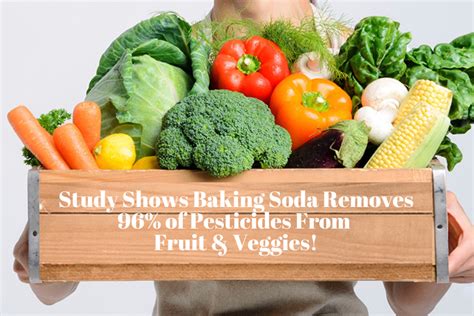
A simple baking soda bath proves more effective than plain water at removing pesticides from the surface of apples, according to research published in the Journal of Agricultural and Food Chemistry. A solution of baking soda and water can significantly reduce pesticide residue on fruit, offering a readily accessible method for consumers to minimize their exposure to potentially harmful chemicals.
A study highlighted in the Journal of Agricultural and Food Chemistry revealed that washing apples with a baking soda solution is a more effective method of removing pesticides than rinsing with tap water alone. The research indicated that a baking soda solution can degrade certain pesticides, offering a practical and accessible method for consumers to reduce their exposure to these chemicals. This finding underscores the potential benefits of using common household items to improve food safety.
The research specifically examined the effectiveness of baking soda in removing two common pesticides: thiabendazole, a fungicide, and phosmet, an insecticide. Apples were treated with these pesticides, and then washed using three different methods: tap water, a baking soda solution, and a two-minute wash in a baking soda solution. The results showed that the baking soda solution was significantly more effective at removing pesticide residue compared to tap water.
According to the study, a 15-minute soak in a baking soda solution was most effective at removing pesticides from the surface of the apples. While this method doesn’t entirely eliminate all traces of pesticides, it substantially reduces the amount present, providing a safer option for consumers. “Baking soda is effective at degrading pesticides on the surface of apples,” the study’s authors noted.
The research team emphasized that washing produce with baking soda is a simple and affordable way for consumers to take greater control over their food safety. This method is particularly useful for individuals concerned about the potential health risks associated with pesticide exposure. By adopting this practice, consumers can proactively reduce their intake of these chemicals and minimize potential adverse effects.
The study’s findings contribute to the growing body of research exploring methods for reducing pesticide exposure through simple food preparation techniques. As concerns about pesticide residues on produce continue to rise, studies like this offer valuable insights into practical strategies for mitigating these risks. The use of baking soda represents a readily accessible and cost-effective solution for consumers seeking to enhance the safety of their food.
Detailed Findings of the Study
The Journal of Agricultural and Food Chemistry study provided a detailed analysis of the effectiveness of baking soda in removing specific pesticides from apple surfaces. The researchers meticulously designed experiments to compare the efficacy of different washing methods, including tap water and a baking soda solution. The study’s methodology and results shed light on the potential benefits of this simple household remedy.
Methodology
The study involved several key steps to ensure accurate and reliable results:
- Pesticide Treatment: Apples were treated with two common pesticides, thiabendazole and phosmet, at concentrations typically found in agricultural applications.
- Washing Procedures: The apples were then subjected to three different washing treatments:
- Rinsing with tap water for a specified period.
- Soaking in a baking soda solution (typically a mixture of baking soda and water).
- Soaking in a baking soda solution for a longer duration, such as 12-15 minutes.
- Residue Analysis: After each washing treatment, the researchers carefully analyzed the pesticide residue remaining on the surface of the apples. This involved sophisticated analytical techniques to measure the concentration of thiabendazole and phosmet.
- Control Groups: Control groups of apples were included in the study to provide a baseline for comparison. These apples were not treated with pesticides and were not subjected to any washing treatments.
Results
The study’s results demonstrated that a baking soda solution was significantly more effective at removing pesticide residue compared to tap water alone. Specifically, the researchers found:
- A 15-minute soak in a baking soda solution removed a substantial portion of the thiabendazole and phosmet from the apple surfaces.
- The longer the apples were soaked in the baking soda solution, the greater the reduction in pesticide residue.
- Tap water alone had a limited effect on removing the pesticides, indicating that the baking soda played a crucial role in degrading or removing the chemicals.
The researchers concluded that baking soda is effective at degrading pesticides on the surface of apples, providing a simple and affordable method for consumers to reduce their exposure to these chemicals.
Mechanism of Action
The study suggests that baking soda’s effectiveness in removing pesticides is likely due to its alkaline properties. Baking soda, or sodium bicarbonate, has a pH of around 8.3, making it a mild base. This alkalinity can help to break down certain pesticides through a chemical process called alkaline hydrolysis.
Alkaline hydrolysis involves the reaction of a chemical compound with water in the presence of a base, leading to the breakdown of the compound into simpler, less toxic substances. In the case of thiabendazole and phosmet, the alkaline environment created by the baking soda solution may facilitate the hydrolysis of these pesticides, breaking them down into less harmful byproducts.
The study did not delve deeply into the specific mechanisms of action, but it provided evidence that baking soda is effective in reducing pesticide residues. Further research may be needed to fully elucidate the chemical processes involved in this degradation.
Implications for Consumers
The findings of this study have significant implications for consumers who are concerned about pesticide exposure through their diet. By adopting the simple practice of washing produce with a baking soda solution, individuals can take greater control over their food safety and potentially reduce their intake of harmful chemicals.
The study highlights the importance of washing fruits and vegetables thoroughly before consumption, regardless of whether they are conventionally grown or organically produced. Even organic produce can be contaminated with pesticides through drift from nearby agricultural operations or through post-harvest handling.
The baking soda method is particularly useful for removing surface residues of pesticides that may not be easily removed by rinsing with water alone. This method can be incorporated into everyday food preparation routines, providing an added layer of protection against pesticide exposure.
Comparison to Other Washing Methods
While the baking soda method has been shown to be effective in reducing pesticide residues, it is important to compare it to other common washing methods to understand its relative benefits and limitations.
- Tap Water: Rinsing produce with tap water is a standard practice for removing dirt and debris. However, as the study demonstrated, tap water alone is not very effective at removing pesticide residues.
- Vinegar Solution: Some people use a vinegar solution to wash produce, believing that the acidity of the vinegar can help to break down pesticides. While vinegar may have some effect on certain pesticides, it has not been as extensively studied as baking soda.
- Commercial Produce Washes: There are numerous commercial produce washes available on the market, which are specifically formulated to remove pesticides and other contaminants. These products may be effective, but they can be more expensive than using baking soda.
- Peeling: Peeling fruits and vegetables can effectively remove surface residues of pesticides, but it also removes valuable nutrients and fiber. Peeling is not always practical or desirable, especially for thin-skinned produce like apples and berries.
Overall, the baking soda method offers a balance of effectiveness, affordability, and accessibility. It is a simple and practical solution that consumers can easily incorporate into their food preparation routines.
Limitations of the Study
While the study provides valuable insights into the effectiveness of baking soda in removing pesticides, it is important to acknowledge its limitations.
- Limited Pesticides: The study only examined the effectiveness of baking soda against two specific pesticides, thiabendazole and phosmet. It is possible that baking soda may not be as effective against other types of pesticides.
- Apple Specific: The study was conducted using apples as the test subject. The effectiveness of baking soda may vary depending on the type of produce being washed. Different fruits and vegetables have different surface characteristics that could affect pesticide removal.
- Surface Residue Only: The study focused on removing pesticide residues from the surface of the apples. It did not address the issue of pesticides that may have penetrated the fruit’s flesh. Some pesticides are systemic, meaning they are absorbed by the plant and distributed throughout its tissues. These types of pesticides cannot be removed by washing.
- Controlled Environment: The study was conducted in a controlled laboratory environment. The effectiveness of the baking soda method may vary under real-world conditions, where factors such as water quality and produce handling practices can influence the results.
Despite these limitations, the study provides strong evidence that baking soda can be a useful tool for reducing pesticide exposure.
Expert Opinions and Recommendations
Health experts and food safety advocates generally support the practice of washing produce to remove pesticide residues and other contaminants. Many recommend using a combination of methods, including rinsing with water, scrubbing with a brush, and soaking in a solution of baking soda or vinegar.
The Environmental Protection Agency (EPA) provides guidelines for reducing pesticide exposure through food. These guidelines include washing produce thoroughly, peeling fruits and vegetables when appropriate, and buying organic produce when possible.
The World Health Organization (WHO) also recommends washing fruits and vegetables before consumption to remove dirt, debris, and pesticide residues. The WHO emphasizes the importance of using clean water and avoiding the use of harsh chemicals that could contaminate the food.
Consumers are encouraged to stay informed about pesticide use in agriculture and to take proactive steps to protect themselves and their families from potential health risks. Washing produce with baking soda is a simple and effective way to reduce pesticide exposure and promote food safety.
Beyond Baking Soda: Additional Tips for Reducing Pesticide Exposure
While washing produce with baking soda is a valuable tool for reducing pesticide exposure, it is important to adopt a comprehensive approach to food safety. Here are some additional tips for minimizing your exposure to pesticides:
- Buy Organic When Possible: Organic produce is grown without the use of synthetic pesticides and fertilizers. While organic produce may be more expensive, it can provide a significant reduction in pesticide exposure.
- Prioritize the Dirty Dozen: The Environmental Working Group (EWG) publishes an annual list of the “Dirty Dozen,” which identifies the fruits and vegetables with the highest levels of pesticide residues. Consumers may want to prioritize buying organic versions of these items.
- Wash All Produce: Regardless of whether produce is conventionally grown or organically produced, it is important to wash it thoroughly before consumption. Even organic produce can be contaminated with pesticides through drift from nearby agricultural operations or through post-harvest handling.
- Peel Fruits and Vegetables: Peeling fruits and vegetables can effectively remove surface residues of pesticides, but it also removes valuable nutrients and fiber. Peeling is most appropriate for thick-skinned produce like oranges and avocados.
- Trim Outer Leaves: For leafy greens like lettuce and spinach, trimming the outer leaves can help to remove pesticide residues and other contaminants.
- Grow Your Own Food: Growing your own fruits and vegetables is a great way to control the use of pesticides and ensure that your food is safe to eat.
- Stay Informed: Stay informed about pesticide use in agriculture and the potential health risks associated with pesticide exposure. Consult reputable sources of information, such as the EPA, the WHO, and the EWG.
Future Research Directions
The study on baking soda and pesticide removal opens up several avenues for future research:
- Effectiveness Against Other Pesticides: Further research is needed to evaluate the effectiveness of baking soda against a wider range of pesticides. Different pesticides have different chemical properties, and baking soda may not be equally effective against all of them.
- Mechanism of Action: A more detailed investigation into the mechanism of action of baking soda in degrading pesticides would be valuable. This could involve identifying the specific chemical reactions that occur when baking soda comes into contact with pesticides.
- Impact on Nutrient Content: Research is needed to assess the impact of washing produce with baking soda on its nutrient content. It is possible that the baking soda solution could leach out certain vitamins and minerals.
- Optimal Washing Conditions: Further studies could explore the optimal washing conditions for maximizing pesticide removal. This could involve varying the concentration of baking soda, the duration of soaking, and the water temperature.
- Real-World Applications: Research is needed to evaluate the effectiveness of the baking soda method under real-world conditions. This could involve conducting studies in households or commercial food preparation settings.
Frequently Asked Questions (FAQ)
1. Does washing produce with baking soda completely remove all pesticides?
No, washing produce with baking soda does not completely remove all pesticides. The study showed a significant reduction in pesticide residue, but some traces may still remain. The effectiveness depends on the type of pesticide, the duration of soaking, and the characteristics of the produce.
2. What is the recommended concentration of baking soda for washing produce?
The study did not specify a precise concentration, but generally, a solution of 1-2 teaspoons of baking soda per cup of water is recommended. You can adjust the concentration based on the amount of produce and the size of the container. Ensure the baking soda is fully dissolved in the water before adding the produce.
3. How long should I soak produce in a baking soda solution?
The research suggested that a 12-15 minute soak in a baking soda solution is effective. Soaking for longer periods may further reduce pesticide residue, but it’s essential to balance this with the potential impact on the produce’s texture and nutrient content.
4. Is washing with baking soda effective for all types of fruits and vegetables?
The study primarily focused on apples. While the baking soda method is likely effective for other fruits and vegetables with similar surface characteristics, its effectiveness may vary. It’s generally safe to use on most produce, but consider the texture and sensitivity of delicate items like berries.
5. Can I use other types of cleaning agents, like soap or dish detergent, to wash my produce?
No, it is generally not recommended to use soap, dish detergent, or other household cleaning agents to wash produce. These products are not designed for consumption and may leave harmful residues on the food. Baking soda and vinegar are safer alternatives for removing pesticides and contaminants from produce. Use only food-safe cleaning methods for washing fruits and vegetables.









